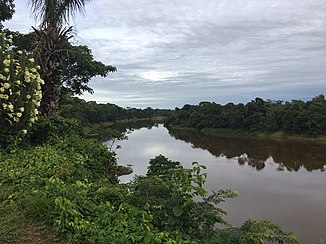Río Blanco (Iténez)
| Río Blanco | ||
|
The Río Blanco |
||
| Data | ||
| location |
|
|
| River system | Amazon | |
| Drain over | Río Iténez → Río Mamoré → Rio Madeira → Amazon → Atlantic Ocean | |
| Headwaters | northwest of Concepción 15 ° 55 ′ 49 ″ S , 62 ° 12 ′ 30 ″ W |
|
| Source height | approx. 400 m | |
| muzzle | at Costa Marques in the Río Iténez coordinates: 12 ° 30 ′ 9 ″ S , 68 ° 39 ′ 10 ″ W, 12 ° 30 ′ 9 ″ S , 68 ° 39 ′ 10 ″ W. |
|
| Mouth height | approx. 130 m | |
| Height difference | approx. 270 m | |
| Bottom slope | approx. 0.25 ‰ | |
| length | 1087 km | |
| Right tributaries | Río Negro, Río San Martín | |
| Small towns | Urubichá | |
| Communities | El Carmen , Bella Vista | |
|
Aerial view |
||
The Río Blanco is a 1087 km long river in the Bolivian part of the Amazon region . It is an important tributary to the Río Iténez / Rio Guaporé , which is part of the border between Bolivia and Brazil .
course
The Río Blanco rises a little northwest of Concepción in the Department of Santa Cruz . At the beginning it runs through Chiquitano dry forest approximately to the west to the vicinity of the country town Urubichá , from there to its confluence rather north to northwest. A little to the northwest of Urubichá, the river reaches the wet rain forests, which are also protected in the national reserve "Río Blanco y Negro". After 465 km it reaches the border with the Beni department , through which it runs another 622 km. Here the vegetation consists of wet rainforests and tropical savannas. In Beni, the Río Blanco passes the town of El Carmen , then a country road follows the river for about 60 km and crosses it with a ferry near the town of Baures , which is only 6 km from the Río Blanco on the parallel Río Negro. The Río Negro flows into the Río Blanco about 10 km north of Baures. As the last village, the Río Blanco passes the country town of Bella Vista . Here, too, the Río Blanco is crossed by a ferry and the 710 km long Río San Martín flows into it from the east as one of the few larger tributaries. The Río Blanco flows into the Río Iténez near the Brazilian city of Costa Marques , which is the border between Bolivia and Brazil.
To a large extent, the Río Blanco runs through very sparsely populated areas, there are only a few localities on its banks. It meanders heavily due to the small slope.
fauna
In the protected area "Río Blanco y Negro", 87 species of mammals, 433 species of birds, 61 species of reptiles and 436 species of fish have been identified. Among them are the three caiman Black caiman , spectacled caiman and Cuvier's Dwarf Caiman . The bird species include the olive shearling , osprey, and plover . Endangered vertebrate species found in the protected area are giant otters , swimming pouches and giant armadillos . The fish species found in the protected area comprise 60% of those in the entire Amazon region.
Individual evidence
- ↑ LOT 10 RÍOS MÁS LARGOS DE BOLIVIA on boliviaturistica.org (Spanish)
- ↑ Río Blanco on esacademic.com (Spanish)
- ↑ Río San Martín on esacademic.com (Spanish)
- ↑ Río Blanco on http://escosistemashumedosenbolivia.blogspot.com (Spanish)

